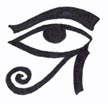|
Mamluk Carpet, late 15th century. Textile Museum. Acquired by George Hewitt Myers in
1953
Mamluk sultans ruled from their
capital in Cairo, Egypt, from the time they wrested power from the
Ayyubids in 1250 until their defeat by the Ottomans in 1517. Mamluk
rugs show consistent color, weave structure, and layout, but appear
unrelated to other known rug weaving traditions.
Textile Museum
description:
Eye of Horus
This 15th-century Mamluk rug
bears repeated images of a design well-known today from the art of
ancient Egypt, the Eye of Horus. According to Egyptian myth, Horus,
the falcon-headed god, lost his eye in a battle with the god Seth.
Restored by the god Thoth, the Eye of Horus became associated with
protection. The eye was often used in pairs on sarcophagi, thought to
provide eyes for the dead.
From the Rhind Papyrus (1650 BCE),
we also now know that the Horus Eye was used as a unit of measurement
for grain. The full composition equaled one hekat, equivalent to
approximately 6 quarts. Each part corresponds to a fractional
measurement expressed as a geometric progression (1/2, 1/4, 1/8, 1/16,
1/32, 1/64).
The Mamluks' extensive use of this pattern, used
in pairs to divide the circle into eighths, suggests that it held
special meaning for them. Why the Mamluks incorporated the Eye of
Horus into their rugs is not known, nor do we know if they knew of its
more ancient significance.
|



